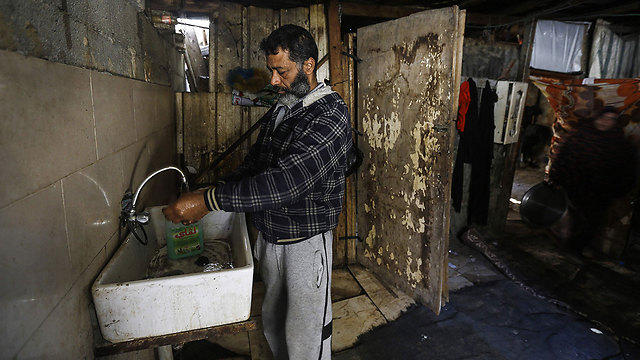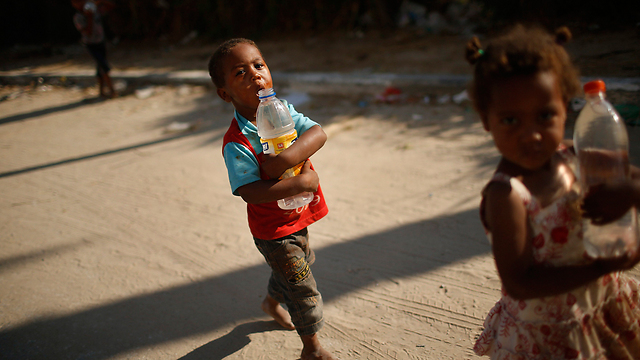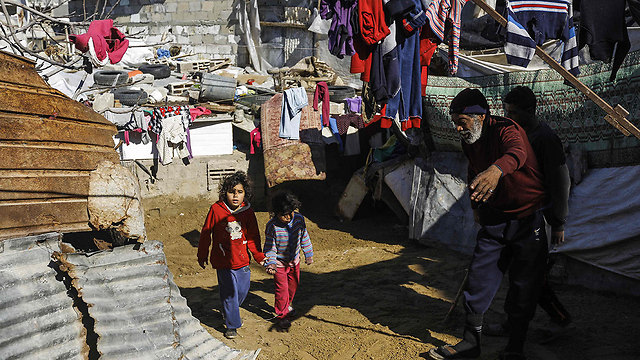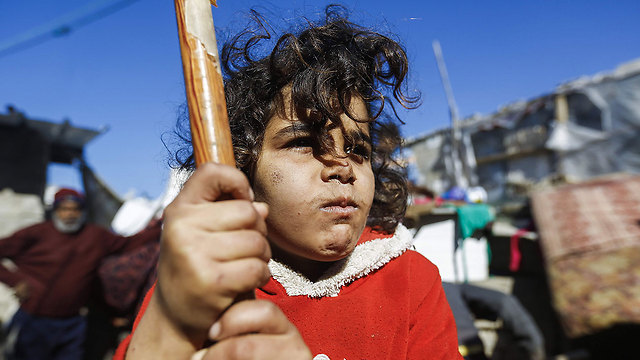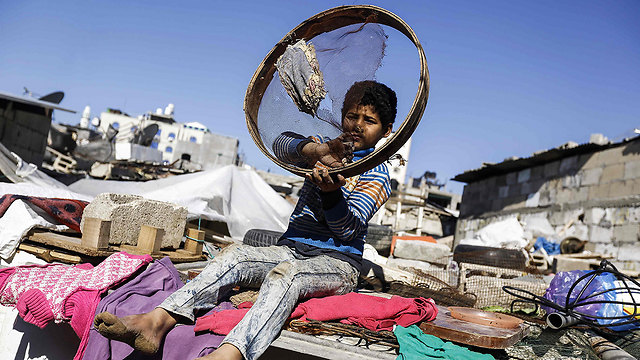
Volatile and dangerous: a look at the humanitarian crisis in Gaza
Analysis: While Israel is engrossed in the comptroller's report on the Security Cabinet's behavior during Operation Protective Edge, over in the Gaza Strip there is a growing sense of civil unrest: with shoddy water infrastructure, polluted ground water, power outages and massive unemployment, Gaza is looking more and more like a powder keg in the making.
Though the last few days in Israel have been all about the comptroller's report on the Security Cabinet's actions and decision during Operation Protective Edge, the current humanitarian situation in the Gaza Strip got no more than a side note in the body of the report. The situation at present is dire as it is, but it's even more concerning due to past experience with Hamas: when faced with public unrest, Hamas has repeatedly chosen to deflect any criticism off itself by instigating a confrontation with Israel. One example of this was during the months that preceded Operation Protective Edge.
Generally speaking, the Israeli defense apparatus prepares itself whenever a wave of protests breaks out in Gaza, fearing that Hamas will respond with an attack on Israel. Such was the case several weeks ago, during Gaza's power shortage, when thousands of citizens took to the streets to demand that Hamas do whatever it takes to make sure Gaza will once again get a regular supply of electricity. It was Qatar and Turkey that eventually provided the solution, in the form of a $12 million check that went toward tens of thousands of tones of gasoline. But as is many times the case there, it was only a temporary fix.
What follows is a list of the most pressing emergencies that have become a daily reality for Gazan residents. Taken together, these issues do not only underscore the immediate needs of Gaza's local population, but also pose a threat to Israel's security:
Water
Two years ago, the United Nations put out a report that found that by 2020, Gaza will no longer have drinkable water. The main reasons for this are the rundown water infrastructure, overly relying on ground water and high levels of chlorine in the water have all contributed to high levels of salinization, which in turn has caused Gazans to use tap water for cleaning and hygiene alone, rather than drinking. While the rich buy desalinized water from private companies for four times the average price an Israeli pays for tap water, local residents mostly rely on public faucets for their water.

Top Israeli security officials have warned for years that Gaza's water situation might very well be the catalyst to bring on a violent response toward Israel. One such source spoke to Ynet back in 2013 that he views Gaza's water crisis as the biggest threat to the stability of Israel's relationship with the strip, and that there is a dire need to erect a second desalinization facility there. At present, only 10% of Gaza's water comes from desalinization or from Israel.
Pollution
Despite the fact that most of Gaza relies almost exclusively on ground water as opposed to desalinization, one third of Gaza's population does not even get to use tap water for cleaning, as they are not connected to the sewage system. Instead, they rely on open sewage ditches and cesspits to rid themselves of the waste they create—both of which pollute the ground water. As a result, Gaza is seeing a rise in illnesses due to drinking contaminated water, particularly among at-risk populations such as children and pregnant women.
Gaza's pollution problem is not contained within the strip, and is a risk to Israel's wellbeing, as well. Most of the sewage in Gaza is transferred into the Mediterranean, which due to sea's northern currents ends up on the beaches of Ashkelon.
To solve this problem, the international community sponsored a $100 million modern sewage purification facility in northern Gaza. The facility has already been erected, but it has not been used once, since there is no electricity to power it: with the shortage in the strip, the purification facility just doesn't get high priority.
Connecting the facility to a designated power line from Israel has already been suggested, and the World Bank has agreed to fund such an endeavor. The problem as it currently stands is that undertaking this project would supposedly require years of planning and coordination. In the meantime, the expensive structure continues to stand untouched, with the pollution continuing to put both Gazans and Israelis at risk.
Electricity
The Gaza Strip currently utilizes one diesel-fueled power plant that was erected in 2002. The plant's maximum potential output stands at about 140 megawatts, yet only puts out between 60-80 megawatts a day.
Israel supplies Gaza with about 120 mega watts via power lines, while Egypt contributes about 30 megawatts.
As such, the daily intake in Gaza stands at around 200 megawatts, despite requiring double that number per day.
This reality creates a situation in which the average home in Gaza receives only 6 – 8 hours a day of electricity. The rest of the time, there is no power flowing into homes and residents are forced to use private generators to meet their needs.
The electricity crisis worsens every few months as the Palestinian Authority, which pays for the diesel that fuels the power plant, demands that Hamas pay a tax on the diesel (which is purchased from Israel), which it refuses to do, despite levying a tax on Gaza residents for power consumption.
These disagreements lead to tension which has resulted in decreased shipments of diesel to the strip, which in turn, results in fewer hours of power for the average household.
The power crisis reached its peak during the winter, when the average home received about 3 – 4 hours of electricity per day, which led to public protest. Currently, the crisis has been contained, but it is only a matter of time before the problem arises once more.
So far, all proposed alternatives, including a Turkish-sponsored, ship-based power station, have not materialized and the frustration among residents has deepened.
Unemployment
The Gaza Strip suffers from a lack of foreign investment over the last decade and workers are not allowed to work in Israel. As a result, according to the World Bank, unemployment in the Gaza Strip has reached frightening levels at 43%.
The amount of unemployment among young people is even more severe, standing at roughly 60%.
The volume of goods leaving the Gaza Strip stands at only 6% relative to the volume of exports the previous decade.
Currently, there are plans to bring workers into Israel, but thus far, they have not materialized.
The amount of factories that are being built and brought into operation cannot bring about the desired change and as such, Gaza residents are supported in large part by international humanitarian organizations.
Gaza Reconstruction
Following Operation Protective Edge, a coalition of donor countries met at a conference in Cairo and pledged some $3.5 billion to the reconstruction of the Gaza Strip. According to a report from the World Bank, only 35% of the amount promised has been transferred. As of last year, only 7% of the required construction material has been delivered.
All of these data reflect a reality that is nearly unbearable, which creates civic pressure that can ultimately directly or indirectly harm Israel.
Talk of the construction of a seaport or airport has been thrown in the air by political and security officials in Israel, but as of now, they are only theoretical.
Steen Jorgensen of the World Bank sums it up by saying "A continuation of the current explosive reality increases anxiety and uncertainty and makes it difficult for Palestinians to imagine a better future. Economic initiatives can aid in building security."










